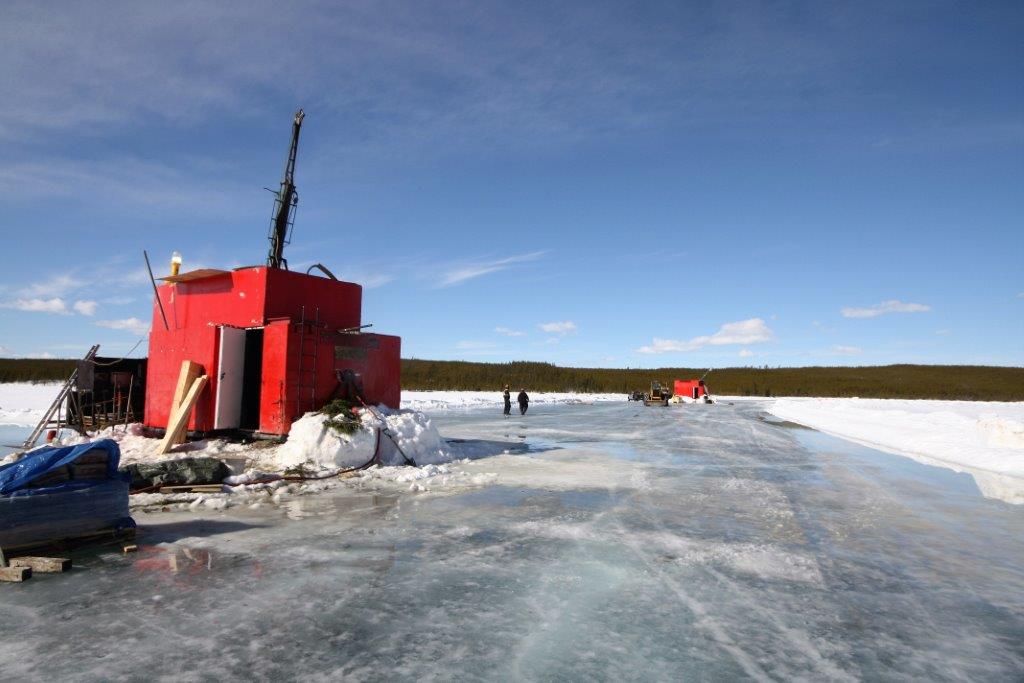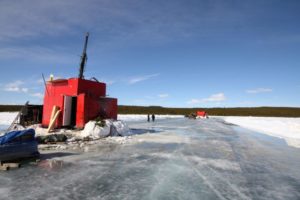Interview with David Cates, President & CEO of Denison Mines

Drill testing on the K-North trend south of the Gryphon deposit at the Wheeler River Project in the Athabasca Basin of northern Saskatchewan. Photo courtesy Denison Mines Corp.
Uranium sector waking up

Denison Mines Corp. [DML-TSX; DNN-NYSE MKT] is launching a major uranium exploration program on its mineral holdings in the prolific Athabasca Basin of northern Saskatchewan. Their $14.5 million (Denison’s share) budget will be focused on the 60%-owned flagship Wheeler River Project. Cameco holds 30% and JCU Canada 10%. Denison also has a 22.5% interest in the operating McClean Lake uranium mill.
At the Wheeler River property, the Phoenix deposit has indicated resources of 70.2M lbs U3O8 grading 19.1% U3O8, and is the highest grade undeveloped uranium deposit in the world. The Gryphon deposit is hosted in basement rock, approximately 3 km northwest of Phoenix, and hosts inferred resources of 43M lbs U3O8 grading 2.3% U3O8.
In an interview with Resource World, David Cates, President and CEO, discusses the outlook for the uranium sector.
RESOURCE WORLD:Â Talking to investors and mining executives, I’m getting two kinds of comments: 1) Uranium is asleep and will stay that way for some time, and 2) the price of uranium is just now starting to recover. What is your take on the uranium price scenario?
DAVID CATES:Â I think this is a real recovery. When we look at global production costs, the best mine in the world is in Kazakhstan. It’s all-in production cost per pound for a breakeven basis is just over US $20 a pound. So that tells me when we were at $18, we couldn’t have justified building the best uranium mine in the world. In this market, that’s break even. To build it, you have to incent it. You have to be at a 20% IRR. We need a price that’s much higher for the best mine in the world to start and we need many mines. Some are being depleted and we need new mines to come on. $18 is not sustainable so I think it’s a real turnaround in the commodity.
RW: Your Wheeler IRR of 20.4% is based on uranium price of US $44 per pound. Does this mean that you will need to wait until uranium reaches that price before you start mining?
DC:Â $44 is just an indicative number. When we did the PEA that was actually the long term price in the market. There’s a spot price and a long term price. Long term prices are term contracts where you deliver pounds over eight or ten years. So we look at that as more meaningful than the spot price because Cameco, Uranium One and other producers in the US are operating on long term contracts. That’s how they realize prices of $50 per pound; so we look at that as more meaningful.
We could do it for less than $44 and still have a commercial return but realistically, we think we’re going to be able to it for much higher than $44 because the market will be paying higher than $44. That price was all about proving that we were justified in advancing the project from PEA to PFS in feasibility. If we needed, say – $65 dollars – to get a commercial return, maybe we wouldn’t be so aggressive in advancing the project.
RW:Â Although the spot price is US $22.50 a pound, it sounds like you are expecting the uranium price to break through $44 in the foreseeable future.
DC: Absolutely! When utilities starting shopping for the next 10 years they will realize that there aren’t enough pounds. Then they are going to look at the developers and that’s what Denison is doing. We’re setting ourselves up so that they see us as the top development pick and when they run out of ore from the producers and the price is going sky-high because they desperately need more pounds for the future, they come to us. We can sign those contracts, build our mine and have a profitable business for the next 10-year cycle.
RW: Are you saying the increasing demand for uranium for new nuclear reactors will force the uranium price higher?
DC: Yes. The scenario for the uranium price is driven by growing demand but it’s a combination of growing demand from Asia, India, Korea and Russia being met with production and supply-side scenario that has almost no growth. At these prices and for such a long bear market, none of meaningful assets have really been able to be advanced. There is a lot of assets in Africa but they need $75 uranium. In our mind Wheeler River is one of the most competitive and we still need 7 to 10 years to build it. So there’s a supply and demand gap that emerges that really can’t be filled by new production. Demand is part of that scenario, but it’s really about new supply on the horizon.
RW: Do you think the drive to have fossil fuel-free energy will make people look more favorably toward uranium?
DC: Yes, nuclear energy is basically steam power. There are no emissions. We know that the Chinese are motivated to clean their air. They have very bad air quality and cannot continue to burn coal. They need to replace their coal energy with nuclear – that’s what they’re doing.
RW: There are other promising uranium discoveries in the Athabasca Basin such as Fission Uranium and NexGen Energy. If other uranium mines come on stream, will that increase the supply too much for the demand?
DC: That’s always a risk with any commodity. If too much supply comes on at once, you end up in an oversupply market. We don’t necessarily see Denison and Fission and NexGen in the same boat. Denison and its Wheeler River are in the eastern part of the Athabasca Basin. We are surrounded by infrastructure and already have an operating licensed uranium mill at McClean Lake with excess capacity. We see ourselves being the developer that builds a mine in this next cycle. We see the Western Basin being the next cycle. We’ve just bought ground in the West because it’s clearly prolific. The discoveries are significant and we want to participate in that, but we bought that ground for the next generation of our business. I don`t see all of these projects coming together at the same time. A lot has to do with permitting, building a mill in the West. That will take time and money and it`s risky. So I see them as staggered and I think that`ll be okay for the market.
RW: Are there still some reactors off-line in Japan and Germany? If so, do you think they will be coming back on-line?
DC: Germany does not look like they will be coming back on line, although the government there could change the answer to that question. We believe Japan is coming back on line slowly. We could see between four and seven more reactors coming on line. Japan has invested billions of dollars for various safety upgrades. Â I don’t see the government or the enterprises spending that kind of money to see the plants not come back on-line. I don’t think they all come on-line, but I think around half of them.
RW: With Denison planning some 60,000 metres of drilling this year, you must have a lot of confidence in the future of the uranium sector.
DC: We believe in the fundamentals of nuclear energy and think the price is unreasonably low and has to go up.
RW:Â Would you like to comment on your recent excellent stock price performance?
DC:Â The uptick in the uranium price has been small and it seems like the share price has moved significantly, but when you look at the Denison share price on the same sort of horizon, you’ll see that there’s a lot of room to go. There’s a lot of room for the uranium price to move and a lot of room for Denison to go up.
